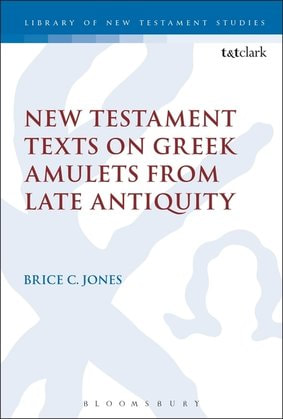|
In the latest issue of the Oxyrhynchus Papyri series (LXXVIII, Egyptian Exploration Society, 2012), W. B. Henry offers an edition of P.Oxy. 5129 (Justin Martyr's First Apology), which is the earliest Greek manuscript of any text of Justin Martyr. According to Henry, "[t]his is the first published ancient copy of a work of Justin Martyr. The text is otherwise known only from the unreliable manuscript A (Parisinus graecus 450, of 1364)." Henry dates the hand to the 4th century CE, citing P.Oxy. 2699 and P.Herm. 5 as comparanda. This is, therefore, an incredible discovery, since P.Oxy. 5129 predates the earliest manuscript of Justin by a millennium! There are a few variants in the fragment (e.g., omission of εντυχειν in 50.12, υμων instead of ημων in 51.4) that make the text important for text-critical study of Justin's First Apology. The manuscript is written on parchment in an elegant hand of the "Severe" type. Unfortunately, only six, partial lines have been preserved (3 lines on hair, 3 lines on flesh), and the flesh side is particularly sparse. Henry collates the text with the critical edition of D. Minns and P. Parvis (2009). For interested readers, I reproduce Henry's transcription of the text of P.Oxy. 5129 below, alongside my own translation (with brackets signifying reconstructions), which is followed by a snapshot of the hair side of the fragment.
11 Comments
[Important announcement on the Papy-list from Cillian O'Hogan ]
The British Library is happy to announce the digitisation of a small group of particularly significant papyri. Available to view online, along with new catalogue entries, are: Egerton Papyrus 2 (P. Lond. Christ. 1/P. Egerton 2, the Egerton Gospel): http://www.bl.uk/manuscripts/FullDisplay.aspx?ref=Egerton_Papyrus_2&index=0 Papyrus 1531 (P. Oxy. IV 654, fragment of the Gospel of Thomas): http://www.bl.uk/manuscripts/FullDisplay.aspx?ref=Papyrus_1531&index=0 Papyrus 2052 (P. Oxy. VIII 1073, fragment of the Old Latin Genesis): http://www.bl.uk/manuscripts/FullDisplay.aspx?ref=Papyrus_2052&index=0 Papyrus 2068 (P. Oxy. IX 1174, Sophocles, Ichneutae): http://www.bl.uk/manuscripts/FullDisplay.aspx?ref=Papyrus_2068&index=0 Papyrus 229 (P. Lond. I 229, Latin deed of a sale of a slave boy): http://www.bl.uk/manuscripts/FullDisplay.aspx?ref=Papyrus_229&index=0 See also the announcement on our Medieval Manuscripts blog: http://britishlibrary.typepad.co.uk/digitisedmanuscripts/2013/10/precious-papyri.html In the coming weeks, we expect to post online Papyrus 131, containing the Athenaion Politeia along with other texts, and the decorated binding of Papyrus 1442 (P. Lond. IV 1419), an eight-century codex containing a tax register. Comments and feedback are very welcome, and we are particularly keen to hear from colleagues who are using the Digitised Manuscripts website in the classroom. Cillian O'Hogan Cillian O'Hogan | Curator of Classical and Byzantine Studies | The British Library Tel. +44 (0)20 7412 7228 In the summer of 2013, while examining various manuscripts in the Beinecke Rare Book and Manuscript Library of Yale University, I came across P.CtYBR inv. 4641, a previously unpublished Coptic parchment codex leaf, and identified it as a copy of the Gospel of John in the Sahidic dialect containing portions of chapter 3. I further realized that this manuscript contains ἑρμηνεῖαι on both the flesh and hair sides, arranged in the same tripartite structure as all other Johannine ἑρμηνεία manuscripts. Among the registered manuscripts containing the Greek text of the Gospel of John, there are a total of five papyrus fragments (P.Vindob. G 26214 [P55], P.Ness. 2 3 [P59], P.Berlin 11914 [P63], P.Vindob. G 36102 [P76], P.Monts. Roca 83 [P80]) and three parchment fragments (lost parchment from Damascus [0145], P.Berlin 3607 + 3623 [0210], and P.Berlin 21315 [0302]) known as ‘hermeneia’ manuscripts, that is, fragments containing a certain passage from the Gospel of John, below which occurs the word ἑρμηνεία (Gk. "interpretation, explanation"), centered on the page, which is then followed by a kind of comment or note on the biblical citation. All of these manuscripts follow precisely this tripartite pattern: 1) some text of John, 2) the word ἑρμηνεία, and 3) a brief comment. P.CtYBR inv. 4641 also follows this tripartite pattern, as these snippets show: As such, P.CtYBR inv. 4641 represents the first-known example of a Coptic-only manuscript with both the text of John and the ἑρμηνεῖαι in Coptic; the other examples that do contain Coptic comments are bilingual. Thus, the Yale fragment has much significance for discussions about the ἑρμηνεία manuscripts, their origin, influences, and functions.
I am happy to announce that my edition of P.CtYBR inv. 4641 has been accepted for publication in New Testament Studies (NTS) and is forthcoming in the April 2014 issue (60.2). In the meantime, I thought I would announce the publication and say a little bit about this interesting manuscript fragment. Stay tuned for more! |
Archives
December 2020
Categories
All
|



